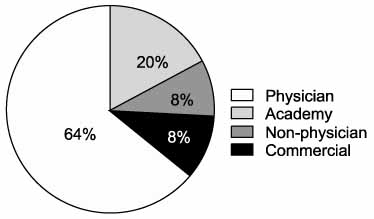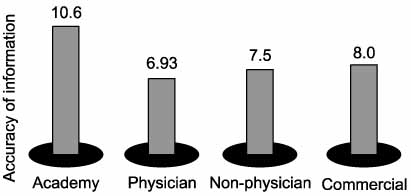J Korean Orthop Assoc.
2008 Aug;43(4):428-432. 10.4055/jkoa.2008.43.4.428.
Evaluation of Website that Provide Information about Scoliosis
- Affiliations
-
- 1Department of Orthopedic Surgery, School of Medicine, Wonkwang University Hospital, Iksan, Korea. ospjy1222@empas.com
- KMID: 1480401
- DOI: http://doi.org/10.4055/jkoa.2008.43.4.428
Abstract
-
PURPOSE: The purpose of this study was to evaluate the quality and accuracy of information on the Web about scoliosis.
MATERIALS AND METHODS
Five search engines were selected and the key word "scoliosis" was entered. 25 web site were chosen. Each Web site was evaluated for the type, quality, accuracy of Web site. Web site type was classified as academic, commercial, physician, nonphysician. Web site quality was evaluated according to scoliosis specific content using 32 disease specific key words. The accuracy was evaluated by three board certified orthopaedic surgeons. One point was given when we agreed with less than 25% of the information and four points were given when we agreed with greater than 75%.
RESULTS
25 Web sites were evaluated, 20% were academic, 64% were physician based. The quality score for academic was 13.4, physician 8.2. The accuracy score for academic was 10.6, physician 6.9.
CONCLUSION
The internet information about scoliosis is limited for quality and information value. The majority of the Web sites were physician site but the quality and accuracy score were poor. The lowest scoring Web sites were physician sites. The public and medical association need to be aware of the limitation of the Web site. The guide line and certification for the Web site about scoliosis should be established.
MeSH Terms
Figure
Reference
-
1. Burton AK, Waddell G, Tillotson KM, Summerton N. Information and advice to patients with back pain can have a positive effect. A randomized controlled trial of a novel educational booklet in primary care. Spine. 1999. 24:2484–2491.2. Galloway P, Zuberbuhler B, Reddy A, et al. A web-based information system for management and analysis of patient data after refractive eye surgery. Comput Method Program Biomed. 2007. 88:210–216.3. Griffiths KM, Christensen H. Quality of web based information on treatment of depression: cross sectional survey. BMJ. 2000. 321:1511–1515.
Article4. Kisely SR. Treatments for chronic fatigue syndrome and the Internet: a systematic survey of what your patients are reading. Aust N Z J Psychiatry. 2002. 36:240–245.
Article5. Lawrence S, Giles CL. Accessibility of information on the web. Nature. 1999. 400:107–109.
Article6. Li L, Irvin E, Guzmán J, Bombardier C. Surfing for back pain patients: the nature and quality of back pain information on the internet. Spine. 2001. 26:545–557.7. Mathur S, Shanti N, Brkaric M, et al. Surfing for scoliosis: the quality of information available on the internet. Spine. 2005. 30:2695–2700.
Article8. Peroutka SJ. Analysis of internet sites for headache. Cephalalgia. 2001. 21:20–24.
Article9. Sharan AD, Vaccaro AR, Albert TJ, Sharan AD. Internet resources for spine surgeons. J Spinal Disord. 2000. 13:419–421.
Article10. Sonnenberg FA. Health information on the Internet. Opportunities and pitfalls. Arch Intern Med. 1997. 157:151–152.
Article
- Full Text Links
- Actions
-
Cited
- CITED
-
- Close
- Share
- Similar articles
-
- The Development of Website-based Food and Nutrition for Women
- Construction a Website for Premature Infant : Based on the Survey of Previous Homepages
- Development of a Website-Based Nutrition Education Program for Female College Students and Young Women
- Medical genomic approach to early-onset scoliosis
- An Evaluation Study of Hypertension Information Providing Web Sites on the Internet




